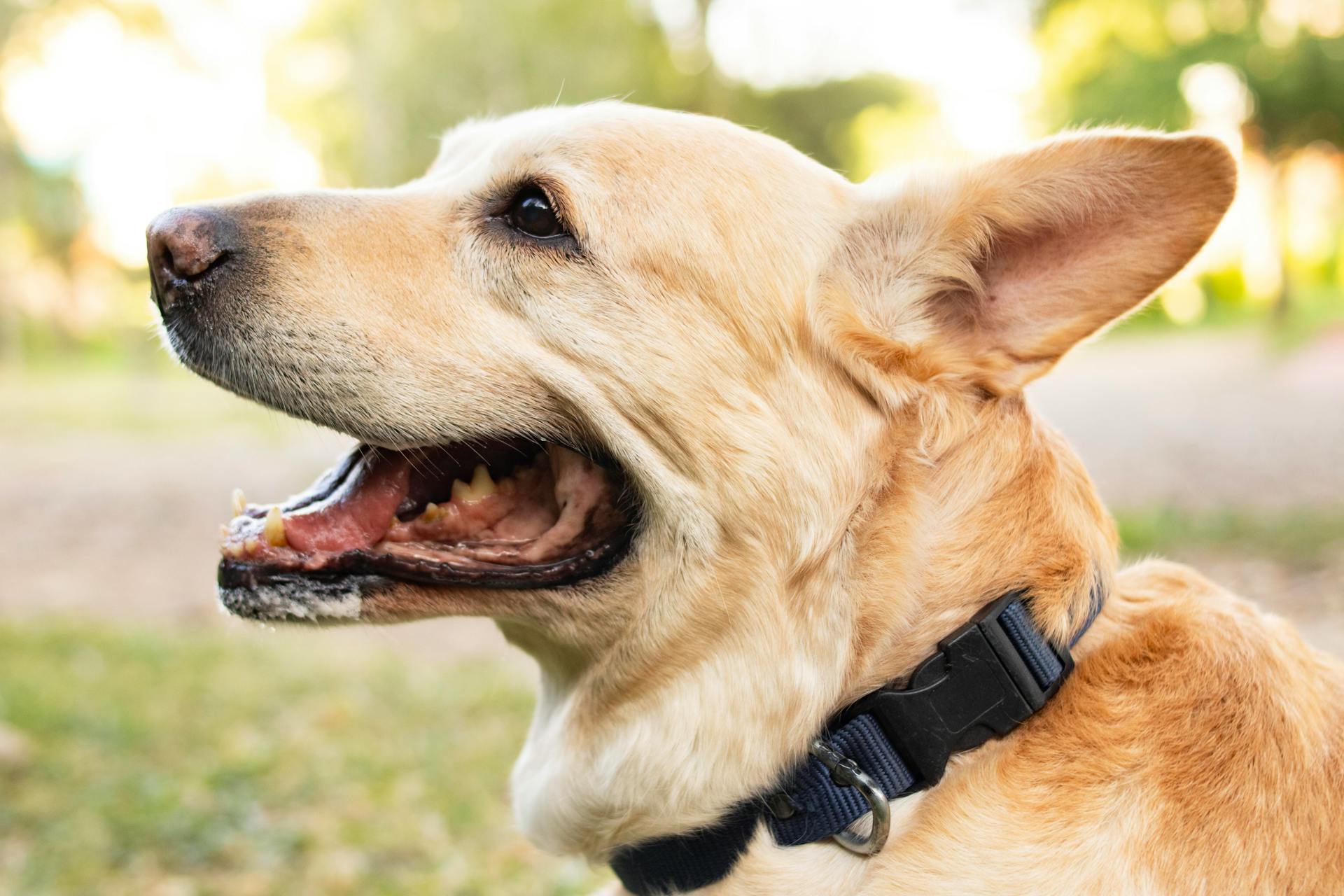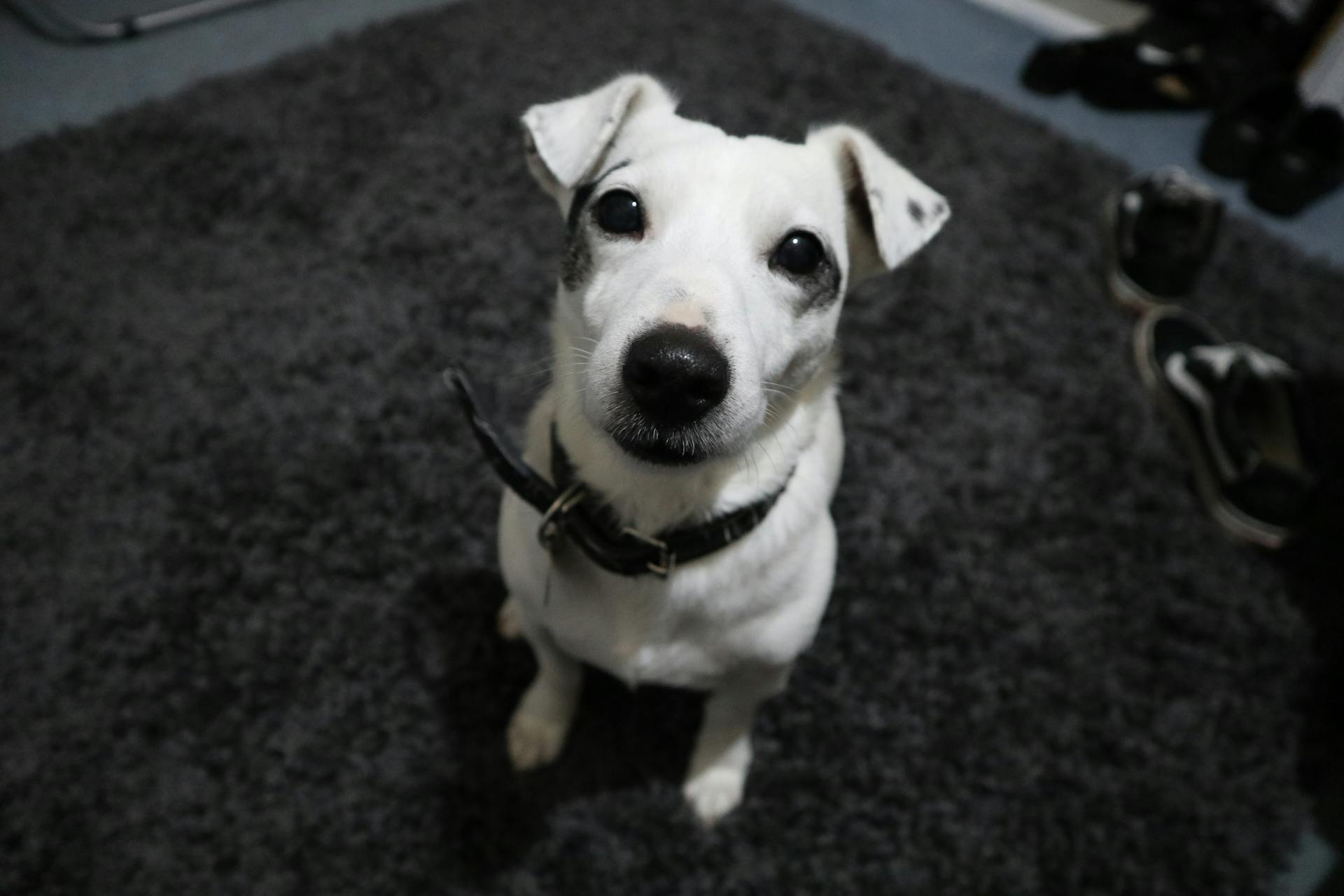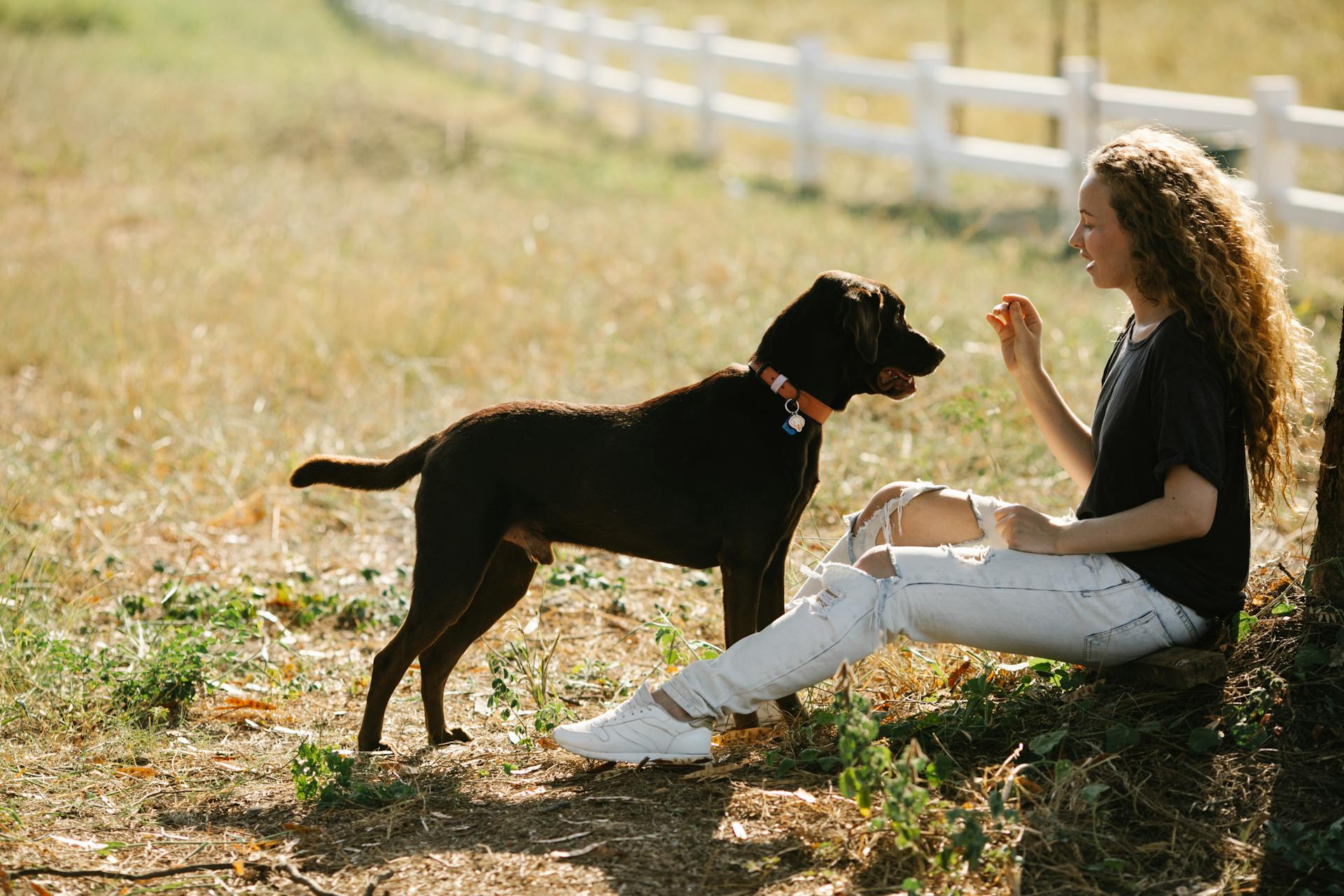
There are several types of dog training collars, each designed to address specific needs and issues in dog training.
Shock collars use electrical stimulation to correct unwanted behavior, but they can be painful and even lead to long-term psychological damage.
Bark collars, on the other hand, are designed to address excessive barking, often using citronella or ultrasonic stimuli to deter the behavior.
Head halters work by applying gentle pressure to the dog's muzzle, helping to steer them in the right direction without causing discomfort.
On a similar theme: Unique Dog Collars for Male Dogs
Types of Dog Training Collars
Every dog is unique, just like people, and what works for one pup may not work for another. This is why choosing the right dog training collar is so important.
Dog training collars can be very effective, but they're not a one-size-fits-all solution. Each type of collar serves a specific purpose, catering to different needs and behaviors.
Some dog training collars can be very successful, but many others are not. This is why it's vital to understand their limitations and capabilities.
Readers also liked: Designer Dog Collars for Large Dogs
There are different types of dog training collars, and understanding their differences is key to finding the right one for your furry companion. Each type of collar has its own strengths and weaknesses.
Here are some of the main types of dog training collars:
Electronic Collars
Electronic collars, also known as E-collars or remote collars, are a type of training collar that uses adjustable wireless electric stimulation to provide feedback on a dog's behavior.
These collars are versatile and can be used for various activities, including off-leash walks, advanced obedience, and even specialized training disciplines like Search and Rescue.
They typically consist of a sturdy collar that sits on the dog's neck and a handheld remote operated by the handler, allowing for effective control even at distances of up to 1,000 feet.
It's essential to find a model with a wide selection of stimulation levels to ensure you can find a level attuned to your dog's behavior. This doesn't mean the collar is more powerful, but rather gives you more control over incremental increases in stimulation.
A good-quality, reputable brand can be expensive, but the investment is worth it for the right tool.
Check this out: Impulse Control Dog Training
Prong
Prong collars are a type of collar that can be used to correct problematic behaviors in dogs, such as jumping, lunging, or pulling.
They're typically made up of chain links with open ends turned towards the dog's neck, designed to apply pressure while preventing the prongs from pinching the skin.
Prong collars are not suitable for small or sensitive-necked dogs, so it's essential to consider your dog's size and temperament before using one.
A prong collar should only be used for training in specific situations and should never be left on a dog after a training session is complete.
Correctly fitting the prong collar is crucial, and it should be fitted high on the dog's neck, tight enough to ensure effective pressure.
Prong collars can be an effective correction tool, making situations safer for dogs and owners alike, but they can be difficult to put on and remove, especially for inexperienced users.
Curious to learn more? Check out: Metal Dog Training Collars
Here are some key pros and cons of prong collars:
- Effective correction tool
- For issues like jumping or lunging, the prong collar will act as a self-correcting tool.
- For inexperienced users, they can be difficult to put on/remove from your dog
- Cannot be left on your dog for prolonged periods of time.
Prong collars typically retail at around $20 to $30, depending on the size, so they're a relatively affordable option for dog owners.
E-
E-collars, also known as remote collars, are a versatile tool for dog training.
They usually consist of a sturdy collar that sits on the dog's neck and a handheld remote operated by the handler. The remote sends adjustable wireless electric stimulation to provide feedback on the dog's behavior.
The receiver typically has adjustable levels that alter the level of stimulation. This allows you to find a level that's attuned to your dog's behavior.
A wide selection of levels doesn't mean the E-collar is more 'powerful', it simply means you have more control over incremental increases in stimulation.
E-collars can be used in a range of activities, from advanced obedience work to off-leash walks, and even in specialized training disciplines like Search and Rescue.
Take a look at this: Dog Training Levels
Some E-collars even include a GPS tracker to help locate the dog.
To use an E-collar effectively and safely, it's essential to seek advice from a professional, certified dog trainer if you're unsure how to operate it correctly.
A good-quality, reputable brand can be expensive, but it's worth the investment for a reliable and safe training tool.
Here are the pros and cons of E-collars:
- Versatile – can be used for a range of activities
- Offers unparalleled control for off-leash walks, advanced obedience, etc.
- A good-quality, reputable brand can be expensive
- Requires knowledge of how to use them effectively and safely.
Shock, Electronic
Electronic collars, also known as E-collars, are a type of training tool that uses electrical stimulation to correct a dog's behavior. They're often used for off-leash walks and advanced obedience training.
These collars usually consist of a sturdy collar that sits on the dog's neck and a handheld remote operated by the handler. The remote sends adjustable wireless electric stimulation to provide feedback on the dog's behavior.
You can use E-collars as a corrective tool or a communication tool. They're especially useful when your dog is working away from you, such as during search and rescue training or off-leash walks.
For your interest: What Is an E Collar for Dog Training
A good-quality E-collar can be expensive, but it's essential to find one with a wide selection of stimulation levels. This will give you more control over the level of correction your dog receives.
Here are some key benefits of E-collars:
- Versatile – can be used for a range of activities
- Offers unparalleled control for off-leash walks, advanced obedience, etc.
It's crucial to seek advice from a professional, certified dog trainer if you're unsure how to operate an E-collar correctly.
Head Collars
Head collars are designed similarly to halters used for horses, and are often branded as "humane and gentle" to pet owners.
They're typically placed just below the eyes, not on the bridge of the nose like halters for horses.
These types of collars sit on the muzzle, which is very sensitive and dogs use to communicate, play and eat, and defend themselves.
Your pup can still eat, drink, bark, and bite while wearing a head collar.
Head collars offer advantages such as being safer, gentler, and sturdier than other types of collars.
Head
Head collars are designed similarly to halters used for horses, but they rest just below the eyes, not on the bridge of the nose like horse halters do.
They sit on the muzzle, which is a very sensitive area that dogs use to communicate, play and eat, and even defend themselves.
Here are some key features of head collars:
- Safer
- Gentler
- Sturdier
Your pup can still eat, drink, bark, and bite with a head collar on, so you don't have to worry about restricting their natural behavior.
Head Halter
The Head Halter is a great option for dogs that pull during walks, but it may require some training for your dog to accept it willingly.
This collar is designed to be soft on the neck while offering superior control, which makes it perfect for strong pullers.
With its design reminiscent of a horse's bridle, the Head Halter allows you to control your dog's head movements, giving you enhanced command.
The Head Halter is an effective choice for dogs that tend to pull, but it's essential to consider your dog's specific needs before making a decision.
Consider reading: No Pull Dog Harness Training
Slip Collars
Slip collars are a great option for dog owners, providing an alternative to traditional collars that tightens without choking.
They're worn high on the dog's neck, which encourages natural walking and reduces the likelihood of pulling forward or sideways during walks.
This type of collar is suitable for most dogs and offers a balance between effectiveness and gentleness.
Choke Chain
The Choke Chain is a type of collar that's designed to grab your dog's attention. It's typically 1 to 2 inches in length with two rings at the end.
The Choke Chain wraps around your dog's neck just under the ears, with the ring connecting to the leash going over the front. This is in contrast to the dead ring, which doesn't tighten when attached to the leash.
The live ring, on the other hand, tightens the chain when pulled and loosens it when released. This makes it a choice for experienced trainers who understand its limitations.
Expand your knowledge: Dog Training Chain Collar
Proper usage of the Choke Chain is crucial to prevent potential injuries. Leaving it on your dog unattended is not recommended by Julie and the rest of the CanineJulz team.
Here's a quick breakdown of the two rings on a Choke Chain:
- The dead ring doesn't tighten when attached to the leash.
- The live ring tightens the chain when pulled and loosens it when released.
Slip
Slip collars are designed to provide an alternative to traditional collars that tightens without choking. They're suitable for most dogs and offer a balance between effectiveness and gentleness.
Limited slip collars are a type of slip collar that's specifically designed to stop tightening before they can choke or constrict. This makes them ideal for dogs that often slip out of their collars.
Slip collars are worn high on the dog's neck, which encourages natural walking and reduces the likelihood of pulling forward or sideways during walks.
Choosing and Classifying
Choosing the right training collar is a crucial decision that can significantly impact your dog's educational journey. Opting for the wrong collar can lead to frustration and even harm your dog.
At Pawious, our collars cater to a diverse range of needs, whether you're an experienced trainer or a novice. Recognizing and comprehending your dog's unique needs and behaviors is of utmost importance in this decision-making process.
The world of dog training is evolving, and the classification of collars for our canine companions is no exception. There are three main categories of collars: Gentle Training Collars, Neck Collars, and Body Harnesses.
Gentle Training Collars serve to correct bad behavior or instill positive habits, such as slip collars. They are designed to be humane and effective.
Neck Collars are designed for behavior correction and come in options like prong collars or choke chains. They are not for every dog, and it's essential to consider your dog's temperament before choosing this type of collar.
Body Harnesses offer control and comfort while correcting behavior and ensuring your dog's well-being. They are a great option for dogs that require more support and stability.
Here's a summary of the three main categories:
Collections and Variations
You can find a wide variety of dog training collars in different categories, making it easier to choose the right one for your furry friend.
There are collars specifically designed for large dogs and small dogs, so you can select the one that fits your dog's size.
Some popular collections include Dog Bark Collars, Dog Training & Shock E-Collars, and Dog Training E-Collars for Large Dogs.
Here are some specific types of dog training collars you can consider:
- Bark Collars for Large Dogs
- Bark Collars for Small Dogs
- Dog Training E-Collars for Large Dogs
- Dog Training E-Collars for Small Dogs
- Long Range Dog Training E-Collars
- Stubborn Dog Training E-Collars
- Waterproof Dog Training E-Collars
- Training E-Collars For Multiple Dogs
The collections also include other types of dog training equipment, such as GPS & Wireless Dog Fences and In-Ground Electric Fences.
Some collections focus on specific needs, like Dog Car Seat Covers and Dog Carriers & Bags for pet owners on-the-go.
You can also find collections that cater to different lifestyles, like Hunting Dog Collars for outdoor enthusiasts.
Frequently Asked Questions
What is the most effective dog training collar?
The most effective dog training collar depends on the specific needs of your dog, but popular options include the Garmin Delta SE for family dogs and the SportDOG 825X for hunting dogs. Discover the best collar for your furry friend's unique needs and training goals.
Will a prong collar stop pulling?
A prong collar may stop a dog from pulling, but it does so by causing discomfort, not by teaching the dog to walk calmly. However, the effectiveness of a prong collar can vary depending on the individual dog and its sensitivity to pain.
Sources
- https://www.kingsdale.com/the-different-types-of-dog-training-collars
- https://highlandcanine.com/blog/different-types-of-dog-training-collars/
- https://www.caninejulz.com/post/dog-training-collars-explained-what-you-need-to-know
- https://pawious.com/blogs/learning-and-helpful-information/the-different-types-of-dog-training-collars-which-one-is-best-for-your-dog
- https://hiddenfence.com.au/what-are-the-different-types-of-dog-training-collars/
Featured Images: pexels.com


